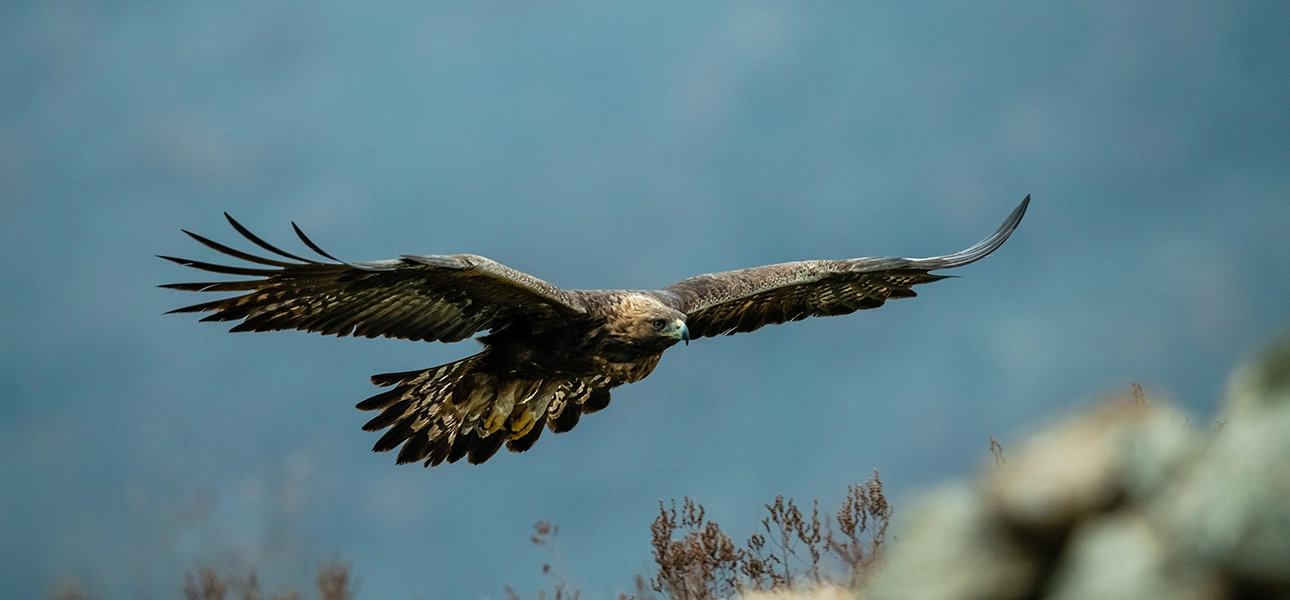
The Golden Eagle is perhaps one of our best-known birds of prey, the iconic bird of wild places. Golden Eagles are one of a group of Aquila eagles found around much of the world. They are both the largest of the group, and the most widely distributed, occurring in North America, Europe, Asia, North Africa, Middle East and east to Japan. It is almost always the largest avian predator where it is found.
Key Facts
Common name: Golden Eagle
Scientific name: Aquila chrysaetos
Habitat: They occur at low density in open upland and mountainous habitats. They are found mostly in the Scottish Highlands, although do also occur at lower density in the lowlands
Diet: Mountain Hares, other similarly sized mammals such as rabbits, brown hares, hedgehogs, foxes and deer calves and birds such as members of the grouse family
Size: Average 82cm, wingspan 212cm. Females (5.3kg) larger than males (3.7kg)
Status: Resident, and breeding bird. Reintroduced to Northern Ireland
Population size: 510 pairs
Conservation status: GREEN (downgraded from AMBER. The population is stable in the UK.)
Appearance
Adult Golden Eagles are dark all over, and young birds have distinctive white tail bases and patches in the wing – very different from the mottled plumage of Buzzard, with a pale necklace and dark ‘elbow’ patches. Despite their size they are elegant and well-proportioned birds, with prominent heads and necks, large, prominent beaks, longish tails and long, almost rakish wings with six fingers (as opposed to Buzzard’s five fingers) at the wing tip. Soaring is carried out on flat wings, rarely tilted up as with Buzzard. Juvenile Golden Eagles are chocolate brown, with mostly white tails except for the end band, and large white patches in the centre of the wings. These white patches shrink over subsequent years as the birds age, but it is at least seven years before adult plumage is acquired, and some birds even older.
Lifespan
The average age is about 23 years, with an adult survival rate of 95% each year. First year survival is not known, but birds have a 15% chance of reaching their fourth year. The oldest known wild bird in the world, was a Scottish bird ringed as a chick in the nest and recovered recently dead 33 years later (ringing recovery). A captive bird is known to have reached 46 years.
Nesting
Across their range birds will nest on the ground or even in a large tree, but British birds almost invariably build an eyrie, consisting of large sticks, on a cliff. Birds pair for life and usually will only change partners if the other dies. Breeding tends to occur first when birds reach 4-5 years old.
Number of eggs: 2
Incubation: 43-45 days
Fledging time: 65-70 days
Habitat and Distribution
Golden Eagles are birds of wild places. They occur at low density in open upland and mountainous habitats. They are found mostly in the Scottish Highlands, although do also occur at lower density in the lowlands. One pair did breed in the Lake District but is no longer present. Recently there has been a re-introduction programme in Northern Ireland in the hope of reestablishing a population.
Aggressive persecution since the 1700s of a large bird of prey that was believed to target farm animals resulted in the Golden Eagle’s extinction in England, Wales and Irelands by the mid-1800s. Some persisted in the wilds of Scotland, but even here they continued to suffer from organochlorine pesticide poisoning. Since the banning of this chemical, numbers have recovered but illegal persecution; disturbance of nesting sites and egg collectors still contribute to breeding failures.
Movements
British Golden Eagles are sedentary, remaining on their vast territories year-round. Young birds will wander for their first few years, exploring the area until they settle. Although birds tend not to wander huge distances, some can turn up in unexpected places. Although very hardy indeed, and able to survive cold conditions, Golden Eagles in other parts of their huge range do migrate, usually in response to a reduction in food availability.
Feeding
Golden Eagles are huge birds and have been accused of taking lambs – but the reality is very different. Despite their great size, like all other birds, eagles are relatively lightweight and cannot carry large weights. The most important food for Golden Eagles is mountain hares, other similarly sized mammals such as rabbits, brown hares, hedgehogs, foxes and deer calves and birds such as members of the grouse family. They will take birds in flight, and are surprisingly agile hunters, and coastal birds will tackle seabirds. Part of their global success is down to their adaptability and being opportunists, taking advantage of any feeding opportunities that come along, and Golden Eagles are certainly not averse to taking carrion.

